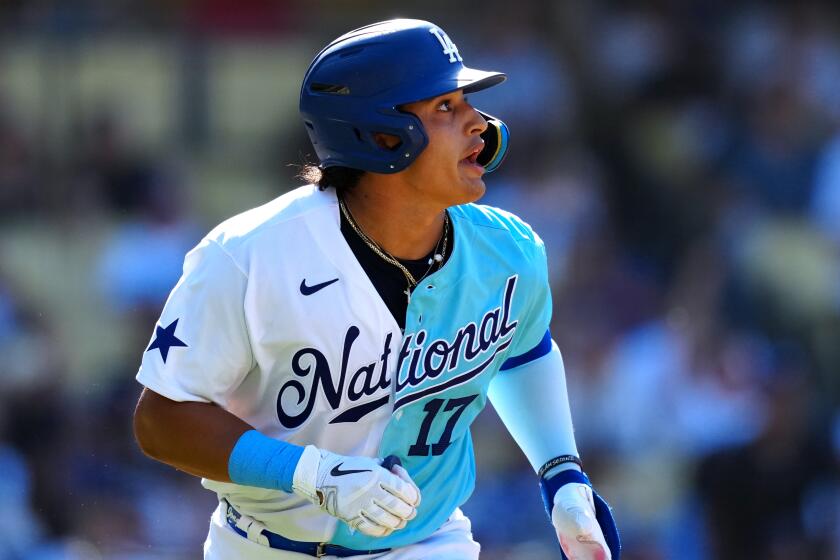Boston’s Fenway Park maintains sense of history, tradition
Reporting from Boston — Dick Bresciani’s favorite spot is a red plastic seat high above the left-field line at Fenway Park, where he has spent many hours alone, staring out at the diamond. He’s been coming to Fenway for 60 years, and has found early in the morning before a game to be his favorite time.
The stands are empty, there’s dew on the impossibly green grass, and it’s almost quiet enough to hear the ghosts of Babe Ruth, Tris Speaker, Ted Williams and the other Hall of Famers who played in the nation’s oldest ballpark.
“It’s so peaceful,” Bresciani says in a thick New England accent that turns “park” into “pawk” and “Sox” into “sawx.”
Baseball has built 21 stadiums in the last two decades, yet the sport’s gem remains Boston’s Fenway, a ballpark that opened six days before the Titanic sank in 1912.
“It just has this mystique, this closeness,” Bresciani says. “Everybody’s close to the action with very little foul ground, so it’s almost like you’re involved. The excitement that’s generated when you come in here and you’re part of this whole environment.
“Then you have the quirks, whether it’s the left-field corner or the triangle or down the right-field line. It’s not like a cookie-cutter stadium.”
Despite all that, Fenway only narrowly dodged a wrecking ball.
In 1999, John Harrington, then chief executive officer of the Red Sox, offered a plan for a new Fenway Park with all the modern, revenue-generating features the Red Sox would need to compete with the free-spending New York Yankees in the American League East — more luxury suites, more premium seating and a larger capacity.
And if Frank McCourt had succeeded in buying the team, a new Fenway probably would have been built, either next door or in South Boston, near waterfront property McCourt owned.
Instead, former Florida Marlins’ owner John Henry took over the team in 2002, finishing a 10-year, $285-million plan to improve Fenway while McCourt moved to Los Angeles and bought the Dodgers.
Since then, the Red Sox have won two World Series and haven’t had a ticket go unsold since May 15, 2003 — a record streak of sellouts that will hit 650 with Sunday’s game against the Minnesota Twins.
Fenway, which offers tours 364 days a year, also has become one of the most popular tourist destinations in the state, according to Lisa Simmons of the Massachusetts Office of Travel and Tourism.
One reason Fenway is experiencing a renaissance a year before its centennial is that, in contrast to the recent wave of retro ballparks that tried to create a faux sense of history through quirky dimensions and a brick-and-steel design, Fenway came by its tradition naturally.
Even with plenty of upgrades and improvements, Fenway remains much the same ballpark Bresciani first entered more than half a century ago.
“I can remember as a kid — and this had to be in the late 1940s — coming up the runway and saying, ‘Whoa, there’s that big green monster out there,’ ” says Bresciani, who is in his 39th year working for the Red Sox, first as the head of public relations and now as a vice president and team historian. “And just the grass. It looked so wonderful.
“It was a day game. And it just looked great.”
That’s important in Boston, where a love for baseball is handed down like an heirloom from generation to generation. Bresciani or any fans who want to reminisce about their first game at Fenway can go back to the row and seat they sat in that day and find the view hasn’t changed.
“The bleachers used to be wooden planks, but the seats are still in the same place the wooden planks were,” Bresciani says. “If you’re sitting in Section 17 Row 10, that’s what was there in 1922.”
Adds Hall of Fame sportswriter Peter Gammons, who saw his first game at Fenway in 1952 and is now a season-ticket holder: “They’ve constantly modernized it. [But] I think people like that old baseball tradition.”
Which is why Fenway is the only major league park where fans enter through a turnstile on a city street. And where fans, no matter where their seats are, are allowed to come down around the dugouts for batting practice.
“People, their grandfathers took them to games and things like that. So they remember what it was like,” Gammons says.
Even when they become the commissioner of baseball, as Massachusetts native and lifelong Red Sox fan Bart Giamatti did. Not surprisingly, his favorite ballpark was Fenway.
“When I was 7 years old my father took me to Fenway Park for the first time,” the late commissioner once said. “As I grew up, I knew that as a building it was on the level of Mount Olympus, the Pyramid at Giza, the nation’s capitol, the czar’s Winter Palace, and the Louvre.
“Except, of course, that [it] is better than all those inconsequential places.”
More to Read
Go beyond the scoreboard
Get the latest on L.A.'s teams in the daily Sports Report newsletter.
You may occasionally receive promotional content from the Los Angeles Times.











